| 1 | The grass snake’s eastern cousin |
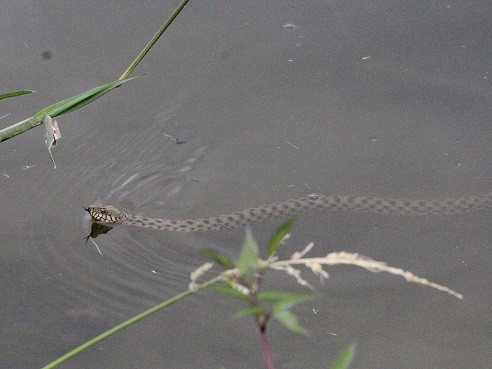
The dice snake is a species that inhabits 3 continents, and is possibly one of the most abundant snakes on Earth. Its westernmost reaches are Switzerland and the river Rhine in Germany, while its eastern flanks stretch into China, Turkmenistan and Mongolia. The southern enclave spills over into the sands of Egypt.
The dice snake is part of the natrix family (natrix tessellata), and is a close relative of the grass snake (natrix natrix) which every British person knows as their island’s signature snake. It’s the grass snake’s eastern cousin, and shares its watery nature, but to an even greater extent. The dice snake is a semi aquatic snake, inhabiting slow moving rivers and lakes, and the sides of small streams.
Unlike the grass snake, it does nearly all of its hunting in the water, and 90% of its diet is fish. Dice snakes often climb branches overhanging water, and drop off when spooked (like the brown watersnake of America). They can remain submerged underwater for hours at a time, surfacing only to take a 2 second breath. The time they do spend on land is for breeding, digesting food and shedding skin. One of their top places is the Danube River, which flows through Europe for 1770 miles.
| 2 | Massively variable colours |
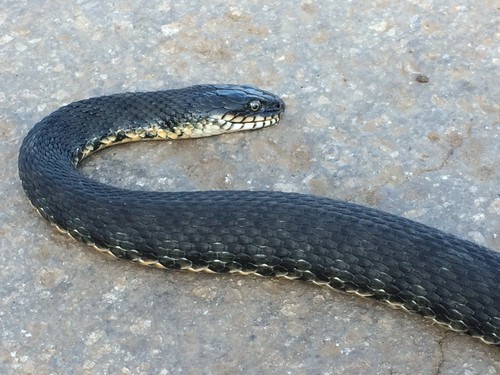
Dice snakes are adapted to their watery worlds, skilled at diving and swimming, and their skull shape is one adaption. Compared to their grass snake relative, their head is narrower and pointed, decreasing water resistance and allowing them to motor forward effortlessly.
The grass snake already has the swimming skills of a speedboat, but the dice snake is superior. They also have eyes and nostrils which are angled upward, for enhanced sight and sound when swimming on the surface. The dice snake is longer than the grass snake, at 1-1.2 metres. Females are bigger, and the oldest ones can pass 1.3 metres.
Spotting a dice snake requires expertise, because their colour varies massively. For example, those in the ancient ruins of Histria in Romania (one of their strongholds) are mainly olive-green, but dice snakes can also be blue-grey, greenish-grey, yellow-olive and reddish brown. Their belly colour also varies – whitish, yellowish, pinkish grey, and even bright red are all possibilities. Even black ones are found sometimes, with a yellow belly.
| 3 | Wrestles but rarely bites |
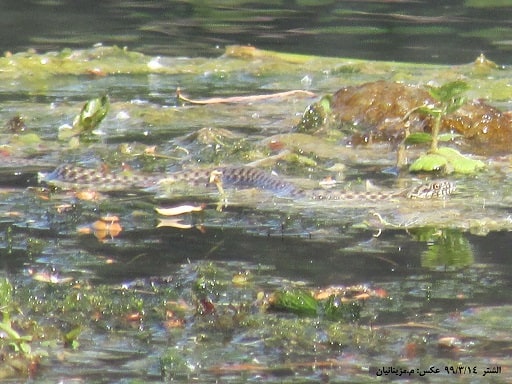
You sit down to fish one morning on the River Danube and realise that you’re 1 metre away from a resting dice snake. What happens next? Firstly, dice snakes almost never attack – being bitten is once in a blue moon levels of rare. A dice snake next to your fishing perch will probably leap into the water instantly and dive deep below the surface.
When picked up, a dice snake normally thrashes and wrestles violently, in a valiant attempt to free itself, and releases a revolting and intolerable smell. They hiss loudly beforehand and can widen their neck slightly in an intimidation display. But an alternative strategy is playing dead. They do this less than the grass snake, but dice snakes will go completely limp in order to fool the aggressor. They’ll open their mouths lifelessly and even fill their own mouths with blood. The larger the dice snake, the more likely to play dead – juveniles usually thrash instead.
For centuries, dice snakes were believed to have no venom, but like dozens of other snakes, they’ve recently been found to have a small Duvernoy’s gland. This backup venom pumper isn’t connected to the front fangs, but secretes a mild toxin into their saliva, which flows into the prey as they chew it (which takes many chews to succeed). The venom is mostly neurotoxic, but no person has ever fallen victim – it would be a fluke within a fluke.
| 4 | Snake Island, Ukraine – the origin story |
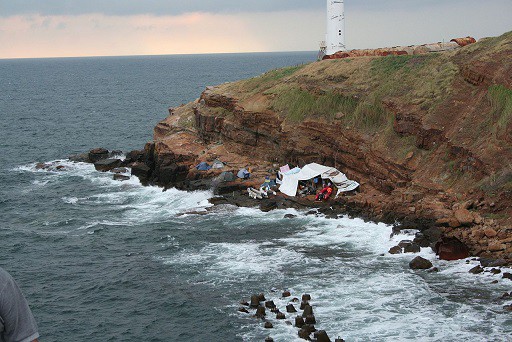
In February 2022, Russia launched a massive invasion of Ukraine, and one of the most heroic stories from the early days was Snake Island. As the hulking steel warship Moskva (which was sunk 2 months later) approached the island, demanding the soldiers’ surrender via loudspeaker, the Ukrainians simply told them to go away, except in far less polite terms.
Their resolve was immortalised in limited edition stamps, and in June 2022, the island was recaptured, with Ukrainians proclaiming victory and the Russians pretending that they’d withdrawn on purpose. Snake Island is an important strategical outpost in the Black Sea, but few asked the question: where did the name come from? The answer is that Snake Island is an ecological zone, swarming with one snake species in particular – the Dice snake.
The island has not just a huge population, but a high amount of fully black melanistic snakes. The dice snakes here are theorised to be a subspecies (Natrix tessellata heinrothi) with minor scale differences, but scientists can’t make their minds up. Sadly, conservationists warned in 2011 that their numbers were dropping dramatically, 3 years after the island finally opened to tourists. Poachers were blamed.
| 5 | Capital: Histria ruins, Romania |
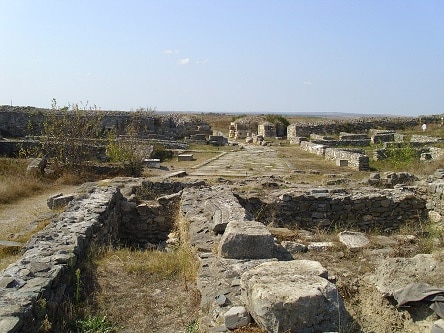
The dice snake is estimated to be the most populous snake in Europe by headcount. In lakes with the perfect habitat, its numbers can swell to gigantic proportions, with thousands in a single water body, like a watery version of a crawling Egyptian tomb. Another of these lies in Histria, Romania. This is an outdoor archaeologist site, home to an ancient merchant town founded in 7th century BC.
Conquered by Romans, the town persisted until 700AD before it was abandoned. Then it was completely buried under sand and Earth, never to be seen before excavations found the first walls in the 20th century. Now it’s an open-air museum, and excavations continue during summer.
But in the winter, the ancient walls are home to hibernating snakes, including the Caspian whipsnake and grass snake. The dice snake far outstrips those two in population. When awake, it spends its time in two lakes not far away. There’s the shallow Lake Sinoa, 2 metres deep and lined with reeds. The second is Lake Istria, which is connected to Sinoa by a channel starting 200 metres from the ruins. It sounds like a videogame level – a labyrinth of stone walls where snakes are around every corner.
| 6 | Hotspot 3 – Golem Grad |
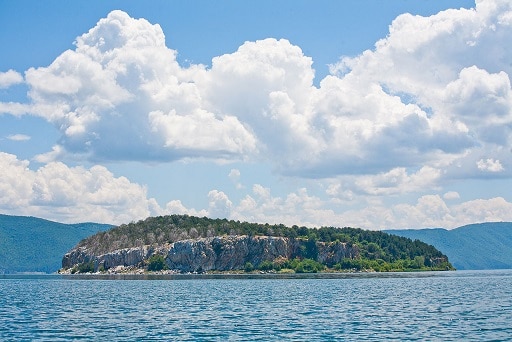
A second snake island can also be found in Macedonia, called Golem Grad, located in Lake Pepsa. Macedonia is land-locked, and at 0.077 sq m, this is the country’s largest island. It’s covered with trees, pelicans, and rocks – and loads of Dice snakes, plus a far smaller number of long-nosed vipers. They peak during summer, when the rocks can be crawling with them. Tourists can sail over by boat, and the name often concerns them, not realising that the dice snakes are harmless.
Golem Grad translates to Big Fortress and is also littered with ancient ruins. There’s 6 churches, including a still intact one devoted to St Peter, and another devoted to St. Demetrius. The oldest artefact may be a mosaic floor with Christian basilica dating back to 4th century AD. The snakes are believed by locals to guard the secret treasure of Tzar Samuel, who ruled Bulgaria from 997 to 1014 and waged war on Hungary.
Rather than being a uniform gene pool, the island has multiple colours of dice snake – spotted (58%), grey (29%) and black (13%). Over in Histria they tend to be olive-green.
| 7 | A fish-eating snake |

The dice snake has the power to eat most food groups, but every molecule of its taste buds is attuned for eating fish, with a minor second course of frogs. An Italian study examined 3 countryside streams, encompassing 1533 prey in total, and reached a verdict of 96.9% fish. A huge study covering multiple European countries found the following food groups: 80% fish, 10% amphibians, 2% mammals, 2% insects, 3% reptiles and 3% gastropods. The only contradictory survey came from central Turkey, where fish didn’t even reach 50%, because of hot summers drying out the water bodies.
The best study happened in a hilly area in central Italy, 60km northwest of Rome, in a stream known locally as Fosso Verginese. The stage was set: it was a zone where the dice snake and its cousin the grass snake lived side by side. The grass snakes would swim and slither through the green fields while the dice snakes stuck to the stream almost exclusively. The result was 97% fish consumed for the dice snake, but only 17% for male grass snakes (females reached 9%). Grass snakes ate 83% amphibians, particularly the common toad (bufo bufo).
Three of the dice snake’s favourite fish species are alburnus alburnus, rutilus rutilus and squalius cephalus, which are very common across Europe. Regardless of location, these fish always seem to pop up.
| 8 | Mindlessly grabs random fish |
The dice snake has no power to coil itself around a fish and constrict, and its venom is weak and diluted and has to be forcibly chewed in. So it goes back to basics instead, and simply grabs the fish, rearranges it, and swallows it down alive. It accomplishes this with a sudden burst of speed, reaching 1 meter per second mid-charge, which is fast for an aquatic snake where water resistance is higher.
For dice snakes, the option of chemical hunting by flecking their tongue is closed off. Water makes picking up those scents extremely difficult, so the dice snake relies heavily on vision instead. Moving prey is what sets them off. A dice snake can swim right past an immobile fish and fail to notice it.
How they hunt depends on whether they’ve eaten recently. A well-fed luxurious snake will sit and wait for a fish to swim by, but anything less, and the leaner, meaner snake will go on the prowl and hunt fish actively. Their hunting speed is extremely low – just 0.1mps.
| 9 | The tricky part – rearranging |
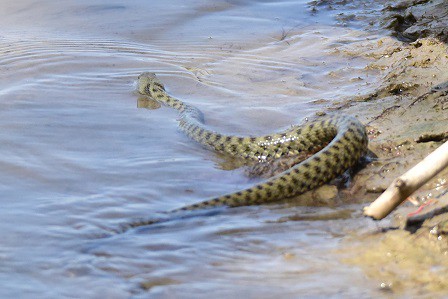
One study used 6 dice snakes captured in Romania. Fish eating snakes generally swallow fish by the head first, to prevent the fins from ripping their insides, and these dice snakes had a rate of 62% headfirst and 38% tail first. When they grabbed a fish by the head, it only took 14.61 seconds to swallow them, from capture to finish. Grabbing and swallowing by the tail took just 18.49 seconds.
But when they grabbed the fish by the torso, it took 63.37 seconds to swallow it by the head, and 40.59 seconds by the tail. Rearranging from head to tail took 246.39 seconds, and vice vera was 201.19 seconds. A dice snake’s ultimate plan is to go for the head, otherwise the slippery fish might wriggle free and escape, but doing so requires focus and ultra-precise timing. 13.25% of fish in the study managed to escape after capture.
That said, the dice snake was faster in every pathway than the false smooth snake of Spain (mildly venomous), which waits for its prey to die before swallowing, and sometimes take 70 minutes.
| 10 | New colony discovered in Egypt |
Natrix tessellata isn’t completely aquatic, as it comes ashore to lay its eggs. Their favourite spot is inside rotting tree stumps, leaf litter or in damp soil, and the number is 4-29. August-September is their usual month for hatching. Dice snakes also come ashore to swallow a particularly large fish, dragging it out of the stream while still in its jaws. This starves the fish of water and ends the struggle far quicker.
Dice snakes are easy to spot by their round beady pupils. Round pupils aren’t uncommon whatsoever in snakes, but the dice snake’s are exceptionally round and even looking, giving it a silly expression, not vicious whatsoever (an appearance that doesn’t lie for once). Like the grass snake, dice snakes have keeled scales, with each pointed at the end to remove all smoothness if you ever managed to stroke one.
New colonies of dice snakes are still being discovered. Its empire is so huge we may never map it all. In 2012, scientists found them in Port Said on the Sinai peninsula in Egypt, speaking to farmers who knew that the snake was safe, but also villagers who attacked them. The snakes had swum in through the freshwater Suez Canal, zooming along a secret passage to colonise an entire region. Streams and rivers are their forte, and mountain streams are no exception: they’ve been spotted at 1800m in altitude in Italy, and 2800m in southeast Europe. Swimming up there must have taken centuries. In Iraqi Kurdistan, a 2 headed dice snake was discovered in 2021.
